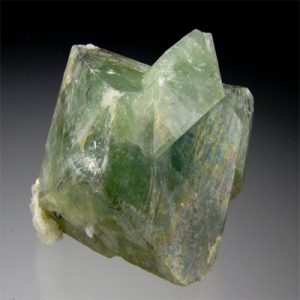Herderite: Gemstone Information
Herderite is recorded by Anthony et al. in Handbook of Mineralogy (2000) as CaBe (PO4)F but there is some doubt about its species status as reported by Mandarino and Back, Fleischer’s Glossary of Mineral Species (2004). Here the same composition is given but queried. There have been no reports of data with F OH. Anthony et al. (2000) report an electron microprobe of a gemstone ‘from Brazil’ which showed F 7% (thus with F 5.86%, the series [with hydroxylherderite] midpoint).
Herderite forms pseudo-orthorhombic crystals of the orthorhombic system by analogy to hydroxylherderite with a hardness 5–5.5. Gem material is transparent and pale in its range of colors which include pink, violet and green, some crystals are colorless. The SG 2.95–3.02 and the RI for the alpha, beta and gamma rays is 1.556–1.59, 1.578–1.61 and 1.589–1.62 respectively, biaxial negative, birefringence 0.029–0.030.A green gemstone from Brazil is noted by Arem, Color Encyclopedia of Gemstones, 2nd edition, 1987; the RI is given as 1.581, 1.601, 1.610 for the three rays with a birefringence of 0.029–0.030.
The Fe content was 7%. Perhaps this was the specimen described by Anthony et al. (op. cit.). Some herderite shows a green or violet fluorescence in both LW and SWUV; some specimens are reported to have shown orange fluorescence and persistent phosphorescence. Herderite is believed to occur in complex granite pegmatites. A transparent green specimen (perhaps the stone already described) weighing 5.90 is in the National Museum of Natural History, Smithsonian Institution, Washington DC, USA. Most gem herderite has come from locations in Minas Gerais, Brazil. Specimens from Maine, USA, described by Bank and Becker (1977) were violet or colorless with RI 1.587–1.590, 1.609–1.610 and 1.619–1.621 with SG fairly constant at 3.00.Brown material from the Virgem do Lapa mine in the same Brazilian state has the high RI 1.610, 1.630 and 1.642. F content was reported to be 0.2%.
Herderite Gemstone: Unveiling Its Mystique and Benefits
Introduction:
Herderite, a gemstone with a subtle yet captivating beauty, holds a rich history and a plethora of metaphysical properties. Named after its discoverer, German mineralogist Wilhelm von Haidinger, Herderite is prized for its rarity and unique characteristics. In this article, we’ll explore the origins, properties, uses, and benefits of Herderite, shedding light on why it continues to fascinate and inspire gem enthusiasts worldwide.
Origins and Characteristics:
Herderite belongs to the phosphate mineral group and is composed of calcium, beryllium, aluminum, phosphorus, and oxygen. It is typically found in pegmatite deposits, where it forms as prismatic or tabular crystals. Herderite crystals can vary in color, ranging from colorless to pale green, yellow, or pink. Its crystal structure often exhibits transparency and brilliance, adding to its allure.
Properties and Features:
One of the most notable features of Herderite is its high beryllium content, which contributes to its rarity and unique properties. Herderite crystals are often prized for their clarity and luster, with some specimens displaying a distinct fluorescence under ultraviolet light. Additionally, Herderite is relatively hard, with a Mohs hardness ranging from 5 to 5.5, making it suitable for use in jewelry with proper care.
Uses in Jewelry:
While not as widely recognized as other gemstones, Herderite is occasionally used in jewelry for its unique beauty and metaphysical properties. Its subtle coloration and exceptional clarity make it an attractive choice for collectors and enthusiasts seeking something distinctive. Herderite is often faceted or cut into cabochons for use in earrings, pendants, or rings, where its subtle elegance can be appreciated.
Metaphysical Properties:
Herderite is believed to possess various metaphysical properties that promote spiritual growth, intuition, and emotional healing. It is often associated with the higher chakras, particularly the third eye and crown chakras, encouraging clarity of thought and spiritual awareness. Some practitioners of crystal healing also believe that Herderite can enhance psychic abilities and facilitate communication with higher realms of consciousness.
Healing Benefits:
In addition to its metaphysical properties, Herderite is believed to have physical healing benefits as well. It is thought to support the nervous system, alleviate stress and anxiety, and promote overall well-being. Herderite is also said to aid in the absorption of nutrients and minerals, helping to maintain a healthy balance within the body. Some individuals use Herderite as a talisman for protection and grounding, carrying or wearing it to maintain a sense of stability and security.
Collectibility and Rarity:
Due to its limited availability and unique properties, Herderite is highly prized among gemstone collectors. Fine specimens with exceptional clarity and color can command premium prices in the gemstone market, particularly among those who appreciate its metaphysical significance. As with many rare gemstones, the value of Herderite is influenced by factors such as size, quality, and provenance, with collectors often seeking out rare and exquisite specimens to add to their collections.
Conclusion:
In conclusion, Herderite stands out as a gemstone with a rich history and a host of intriguing properties. From its subtle beauty and unique characteristics to its metaphysical and healing benefits, Herderite continues to captivate and inspire gem enthusiasts worldwide. Whether admired for its aesthetic appeal or valued for its potential metaphysical properties, Herderite remains a cherished gemstone that embodies both elegance and mystique.





